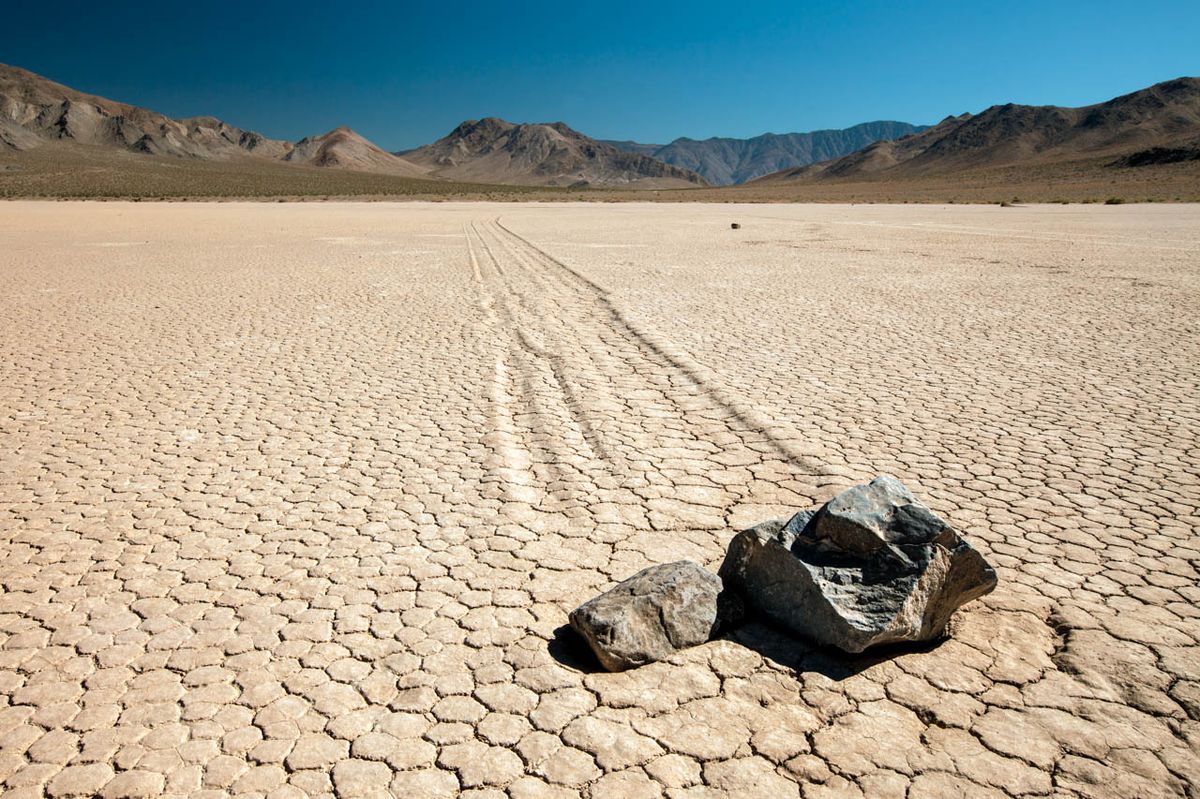Secrets Of Death Valley’s Racetrack Playas

Have you ever heard of Death Valley's Racetrack Playa? This mysterious spot in California's Death Valley National Park is famous for its "sailing stones." These rocks seem to move on their own, leaving long trails behind them on the dry lake bed. Scientists have puzzled over this phenomenon for years. Some thought it was the work of aliens, while others believed in magnetic forces. Recent studies have finally provided some answers, but the magic of Racetrack Playa remains. If you're curious about how these stones move or planning a visit, keep reading to uncover the secrets of this unique landscape.
Mysteries of the Racetrack Playa
Death Valley's Racetrack Playa is a place of wonder and mystery. This dry lakebed, located in one of the hottest places on Earth, is famous for its "sailing stones" that seem to move on their own. Let's uncover some secrets of this fascinating location.
The Sailing Stones
The most intriguing feature of Racetrack Playa is the sailing stones. These rocks, some weighing hundreds of pounds, leave long trails behind them as they move across the desert floor. Scientists have puzzled over this phenomenon for decades.
- Sliding Rocks: The stones move due to a combination of ice, wind, and water. Thin sheets of ice form under the rocks, and when the ice melts, the rocks slide across the wet, slippery surface.
- Wind Power: Strong winds push the rocks, aided by the slick surface created by melting ice. This combination allows the stones to travel significant distances.
- Unique Conditions: The specific conditions of Racetrack Playa—flat terrain, minimal vegetation, and extreme weather—make it the perfect place for this rare phenomenon.
The Playa's Geology
Understanding the geology of Racetrack Playa helps explain why it is such a unique location. The dry lakebed has a fascinating history and composition.
- Clay and Silt: The surface of the playa is made up of fine clay and silt, which become very slippery when wet. This slick surface is crucial for the movement of the sailing stones.
- Seasonal Flooding: During rare rainstorms, the playa floods, creating a shallow, temporary lake. As the water evaporates, it leaves behind a smooth, flat surface.
- Desert Environment: The harsh desert environment contributes to the playa's unique conditions. Extreme temperatures and minimal rainfall create a landscape unlike any other.
Visiting Racetrack Playa
For those who wish to see the wonders of Racetrack Playa firsthand, there are a few things to keep in mind. Visiting this remote location requires preparation and respect for the environment.
- Getting There: Racetrack Playa is accessible by a rough, unpaved road. High-clearance vehicles are recommended, and visitors should be prepared for a long, bumpy drive.
- Best Time to Visit: The best time to visit is during the cooler months, from October to April. Summer temperatures can be dangerously high.
- Leave No Trace: Visitors should follow Leave No Trace principles to protect the fragile environment. This means packing out all trash and avoiding disturbing the rocks or trails.
The Legends and Lore
Racetrack Playa has inspired many legends and stories over the years. The mysterious moving stones have captured the imagination of visitors and locals alike.
- Ancient Myths: Some Native American tribes have legends about the moving stones, attributing their movement to spirits or supernatural forces.
- Modern Mysteries: Even with scientific explanations, the sailing stones continue to fascinate. Many visitors report feeling a sense of awe and wonder when witnessing the trails left by these mysterious rocks.
- Cultural Impact: The playa has appeared in various films, books, and documentaries, further cementing its place in popular culture.
The Beauty of the Playa
Beyond the mysteries, Racetrack Playa offers stunning natural beauty. The stark, otherworldly landscape provides a unique backdrop for photography and exploration.
- Sunrise and Sunset: The playa is particularly beautiful at sunrise and sunset, when the light casts long shadows and creates dramatic contrasts.
- Night Sky: With minimal light pollution, Racetrack Playa is an excellent spot for stargazing. The clear desert skies reveal a breathtaking view of the Milky Way.
- Photography Opportunities: The unique landscape and the trails left by the sailing stones make Racetrack Playa a favorite destination for photographers. The stark beauty of the playa provides endless opportunities for capturing stunning images.
The Mystique of Death Valley's Racetrack Playas
Death Valley's Racetrack Playas hold a unique charm. The moving rocks, known as "sailing stones," have puzzled scientists and visitors alike. These stones glide across the dry lake bed, leaving behind long trails. The phenomenon occurs due to a rare combination of rain, freezing temperatures, and wind. When the conditions align, a thin layer of ice forms, allowing the rocks to move with minimal friction.
Visiting Death Valley offers a chance to witness this natural wonder. The remote location adds to the allure, making it a perfect spot for adventure seekers. Remember to respect the environment by not disturbing the stones or trails. The Racetrack Playas are a testament to nature's ability to surprise and inspire. Whether you're a scientist, a photographer, or just curious, this destination promises a memorable experience.

